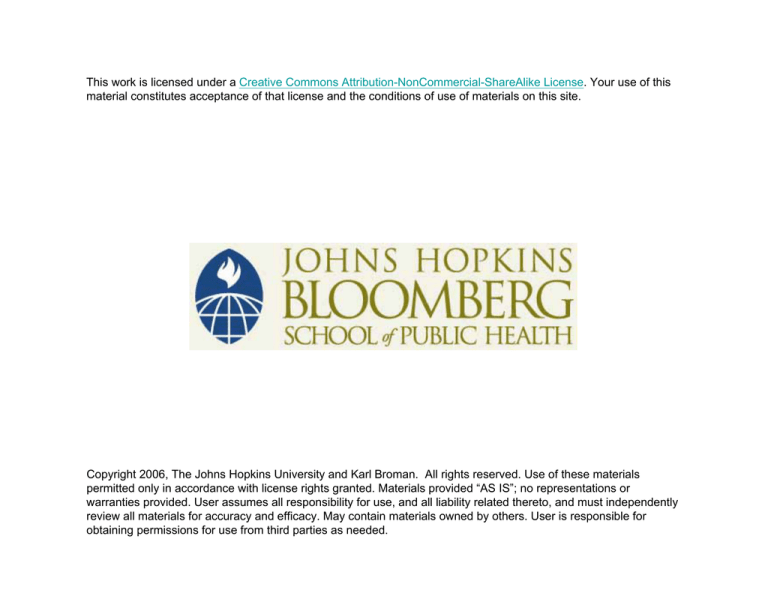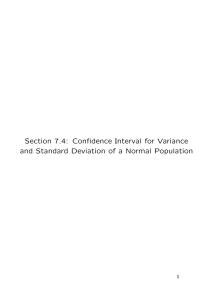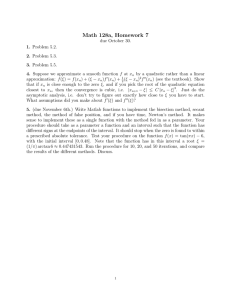
This work is licensed under a Creative Commons Attribution-NonCommercial-ShareAlike License. Your use of this
material constitutes acceptance of that license and the conditions of use of materials on this site.
Copyright 2006, The Johns Hopkins University and Karl Broman. All rights reserved. Use of these materials
permitted only in accordance with license rights granted. Materials provided “AS IS”; no representations or
warranties provided. User assumes all responsibility for use, and all liability related thereto, and must independently
review all materials for accuracy and efficacy. May contain materials owned by others. User is responsible for
obtaining permissions for use from third parties as needed.
Review
If X 1, . . . , X n have mean µ and SD σ ,
E(X̄ ) = µ
no matter what
√
SD(X̄ ) = σ/ n
if the X ’s are independent
If X 1, . . . , X n are iid normal(mean=µ, SD=σ ),
√
X̄ ∼ normal(mean = µ, SD = σ/ n).
If X 1, . . . , X n are iid with mean µ and SD σ
and the sample size, n, is large,
√
X̄ ∼ normal(mean = µ, SD = σ/ n).
Confidence intervals
Suppose we measure the log10 cytokine response in 100 male
mice of a certain strain, and find that the sample average (x̄) is
3.52 and sample SD (s) is 1.61.
√
Our estimate of the SE of the sample mean is 1.61/ 100 = 0.161.
A 95% confidence interval for the population mean (µ) is
3.52 ± (2 × 0.16) = 3.52 ± 0.32 = (3.20, 3.84).
What does this mean?
What is the chance that (3.20, 3.84) contains µ?
Suppose that X 1, . . . , X n are iid normal(mean=µ, SD=σ ).
Suppose that we actually know σ .
√
Then X̄ ∼ normal(mean=µ, SD=σ/ n)
where σ is known but µ is not.
How close is X̄ to µ?
|X̄ − µ|
√ ≤ 1.96 = 95%
Pr
σ/ n
1.96 σ
−1.96 σ
√
≤ X̄ − µ ≤ √
= 95%
Pr
n
n
1.96 σ
1.96 σ
Pr X̄ − √
≤ µ ≤ X̄ + √
= 95%
n
n
σ
n
µ
What is a confidence interval?
A 95% confidence interval is an interval calculated from the data
that in advance has a 95% chance of covering the population parameter.
√
In advance, X̄ ± 1.96σ/ n has a 95% chance of covering µ.
Thus, it is called a 95% confidence interval for µ.
Note that, after the data is gathered (for instance, n=100, X̄ =
3.52, s = 1.61), the interval becomes fixed:
√
X̄ ± 1.96σ/ n = 3.52 ± 0.32.
We can’t say that there’s a 95% chance that µ is in the interval
3.52 ± 0.32. It either is or it isn’t; we just don’t know.
500 confidence intervals for µ
(σ known)
1
2
3
4
5
6
1
2
3
4
5
6
1
2
3
4
5
6
1
2
3
4
5
6
1
2
3
4
5
6
Longer and shorter intervals
If we use 1.64 in place of 1.96, we get shorter intervals with lower
confidence.
|X̄ − µ|
√ ≤ 1.64 = 90%,
Since Pr
σ/ n
√
X̄ ± 1.64σ/ n is a 90% confidence interval for µ.
If we use 2.58 in place of 1.96, we get longer intervals with higher
confidence.
|X̄ − µ|
√ ≤ 2.58 = 99%,
Since Pr
σ/ n
√
X̄ ± 2.58σ/ n is a 99% confidence interval for µ.
What is a confidence interval?
A 95% confidence interval is a obtained from a procedure for producing an interval, based on data, that 95% of the time will produce an interval covering the population parameter.
In advance, there’s a 95% chance that the interval will cover the
population parameter.
After the data has been collected, the confidence interval either
contains the parameter or it doesn’t.
Thus we talk about confidence rather than probability.
But we don’t know the SD
√
Use of X̄ ± 1.96 σ/ n as a 95% confidence interval for µ requires
knowledge of σ .
That the above is a 95% confidence interval for µ is a result of the
following:
X̄ − µ
√ ∼ normal(0,1)
σ/ n
What if we don’t know σ ?
We plug in the sample SD (s), but then we need to widen the
intervals to account for the uncertainty in s.
500 BAD confidence intervals for µ
(σ unknown)
1
2
3
4
5
6
1
2
3
4
5
6
1
2
3
4
5
6
1
2
3
4
5
6
1
2
3
4
5
6
3
4
5
6
1
2
3
4
5
6
500 confidence intervals for µ
(σ unknown)
1
2
3
4
5
6
1
2
3
4
5
6
1
2
3
4
5
6
1
2
The Student t distribution
If X 1, X 2, . . . X n are iid normal(mean=µ, SD=σ ),
X̄ − µ
√ ∼ t(df = n − 1)
s/ n
Discovered by William Gossett
(“Student”) who worked for Guiness.
df=2
df=4
df=14
normal
In R, use the functions pt(), qt(),
and dt().
e.g., qt(0.975,9) returns 2.26
(cf 1.96)
pt(1.96,9)-pt(-1.96,9) returns
0.918 (cf 0.95)
−4
−2
0
2
The t interval
If X 1, . . . , X n are iid normal(mean=µ, SD=σ ),
√
X̄ ± t(α/2, n − 1) s/ n is a 1 − α confidence interval for µ.
t(α/2, n − 1) is the 1 −α/2 quantile of the t distribution
with n − 1 “degrees of freedom.”
α 2
−4
−2
0
2
4
t(α 2, n − 1)
In R: qt(0.975,9) for the case n=10, α=5%.
4
Example 1
Suppose we have measured the log10 cytokine response of 10
mice, and obtained the following numbers:
Data
0.2 1.3 1.4 2.3 4.2
4.7 4.7 5.1 5.9 7.0
x̄ = 3.68
s = 2.24
n = 10
qt(0.975,9) = 2.26
95% confidence interval for µ (the population mean):
√
3.68 ± 2.26 × 2.24 / 10 ≈ 3.68 ± 1.60 = (2.1, 5.3)
95% CI
s
0
1
2
3
4
5
6
7
Example 2
Suppose we have measured (by RealTime-PCR) the log10 expression of a gene in 3 tissue samples, and obtained the following
numbers:
Data
1.17 6.35 7.76
x̄ = 5.09
s = 3.47
n=3
qt(0.975,2) = 4.30
95% confidence interval for µ (the population mean):
√
5.09 ± 4.30 × 3.47 / 3 ≈ 5.09 ± 8.62 = (–3.5, 13.7)
95% CI
s
0
5
10
Example 3
Suppose we have weighed the mass of tumor in 20 mice, and
obtained the following numbers
Data
34.9 28.5 34.3 38.4 29.6
28.2 25.3 . . . . . . 32.1
x̄ = 30.7 n = 20
s = 6.06 qt(0.975,19) = 2.09
95% confidence interval for µ (the population mean):
√
30.7 ± 2.09 × 6.06 / 20 ≈ 30.7 ± 2.84 = (27.9, 33.5)
95% CI
s
20
25
30
35
40






